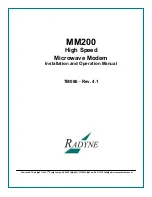
AM64/128A User Manual
Test Menu
27
However, the usage of the EEPROM (Blocks Used) is still displayed for information.
For example:
000
means that the first block is in use and that there are 254 empty blocks.
254
means that the last block is being used and the chip is nearly full.
The failure messages have the following implications:
1. EPROM Fail
This is a fatal error and the program will terminate.
2. EEPROM Fail
This indicates that the internal structuring of the EEPROM data is corrupt.
If this happens an opportunity is given to reset the EEPROM.
To reset the EEPROM, press the select key in response to the
Reset EEPROM ?
prompt.
The consequence of resetting is that some sections of EEPROM memory may be written to more than the
recommended maximum number of times, giving ultimately lower reliability of saved data.
3. EEPROM Csum Fail
This indicates that data in the non-volatile memory (EEPROM) has an incorrect
checksum. This can occur during normal usage if the unit was programming a new configuration when
the power was turned off. Normal operation can resume, but the set up configuration must be re-entered.
5.4.9 Communication Channel Loopback
This loop is very similar to the remote loop feature in that it still applies the loopback at the remote BBM.
The main difference is that the command to turn on the loop is sent via the comms channel (see Appendix C).
This means there is no reliance on the status line to control the loop. The loop can therefore be applied at
ALL rates. Unstructured data, or data with the status line off can be sent around this loop; whereas a
normal remote loop would be cancelled as soon as the status line was turned off.
To activate this loop, press SELECT.
T > Comm Loop Off
The display should then show
T > Comm Loop On
The loop should be applied and the TM LED should come on.
Note: the status menu treats this loop differently, the top level display is NOT
Loop Active
but
Data Transfer
etc.
















































